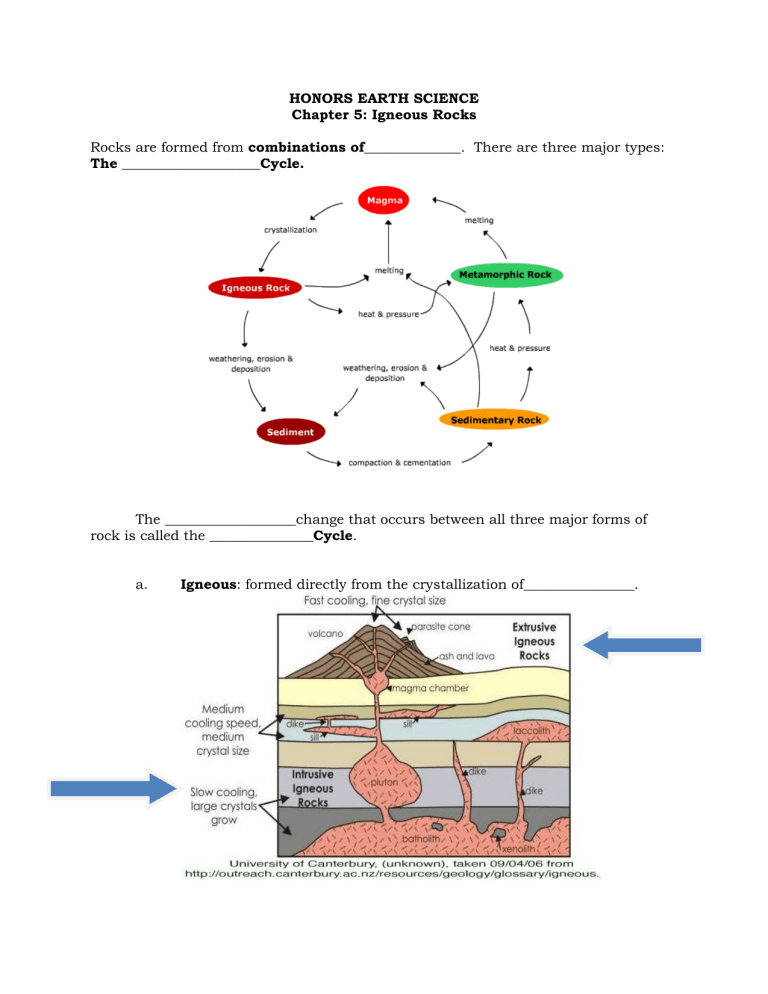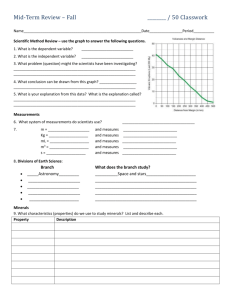File

HONORS EARTH SCIENCE
Chapter 5: Igneous Rocks
Rocks are formed from combinations of______________. There are three major types:
The ____________________Cycle.
The ___________________change that occurs between all three major forms of rock is called the _______________Cycle. a.
Igneous: formed directly from the crystallization of________________.
b.
Metamorphic: rocks exposed to extreme
___________________and____________________________. c. Sedimentary: formed from the _____________________of other rocks
5.1 Igneous Rocks
Where magma (lava) ______________________has a major impact on the type of igneous rock that forms. Fine grained igneous rocks form on the surface
(__________________________) and cool quickly while coarse-grained igneous rocks form beneath the earth’s surface (______________________________).
5.2 Classifying Igneous Rocks
In addition to being classified as either intrusive or extrusive, igneous rocks are grouped based upon their mineral__________________________, ________________size, and________________________.
Igneous rocks are commonly used as _________________________materials because of the _____________________________mineral grains that give them added strength.
Chapter 6: Sedimentary and Metamorphic Rock
Although igneous rocks are the most common type of rock on Earth, the most common type of rock on the _____________________of the Earth is___________________.
This is because the forces of weathering (___________________, __________________,
gravity, and______________________________) and erosion only occur on the
___________________to create sediments.
_____________________________refers to the breaking of rock into smaller and smaller pieces. There are two common types of weathering:
rock.
____________________________: changes the actual chemical composition of the
_____________________: no change in composition; only a change in size.
______________________________refers to the process where weathered materials are carried to a new location (_______________________). Erosion almost always occurs downhill.
___________________________refers to the settling of eroded material on the ground. As more and more sediments are deposited they may undergo
____________________________(change to stone) due to increasing pressure and temperature.
Sedimentary rock typically has the following features: a.
_____________________________: horizontal layering (Principle of
Superposition)
b.
_________________________: bedding occurs at angles to each other c.
_________________________: the remains of once living organisms
6.3: Metamorphic Rock
So far you have learned that _____________________and _____________________ both increase as depth increases. As a result, if rocks are carried far enough into the mantle (subduction) they will turn into____________________.
Rocks can experiences changes in texture and composition even if they don’t reach the extreme conditions needed for melting. During _________________________(
Greek for changing form) rocks change while remaining a__________________-.
Different combinations of temperature and pressure can result in different types (or___________________) of metamorphism (Figure 6-12 on page 133). When these conditions occur over large geographic areas regional metamorphism occurs.







